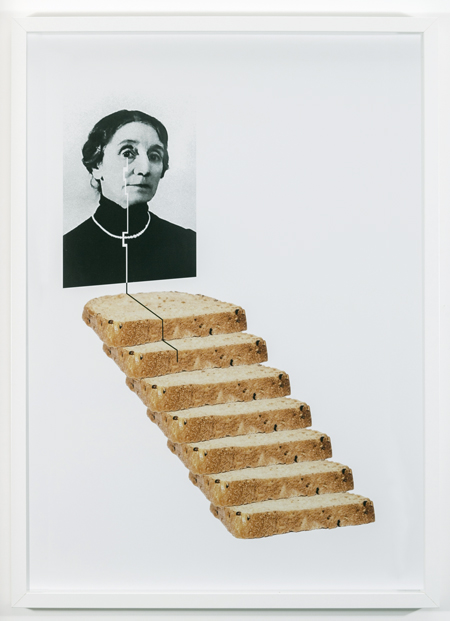Nicola Gobbetto

Appearing on The Muppet Show in 1978, legendary ballet dancer Rudolf Nureyev performed a pas de deux from Tchaikovsky’s Swan Lake (1875–76). After opening with a classic, serious solo, he was joined by a rather full-bodied ballerina squeezed into a white tutu: not Miss Piggy herself, but the Royal Ballet soloist Graham Fletcher in drag, as a porcine dancer resembling the famous puppet.
This memorable piece of TV history provided the point of departure for Nicola Gobbetto’s third exhibition at Galleria Fonti, ‘Bread & Cola’. In the digital animation Pork Lake (all works 2013), the Milan-based artist applied the rotoscope animation technique to vintage footage from various Swan Lake performances by Nureyev, creating a five-minute pastiche that brought together the most famous steps: in the pared-back, video game-like cartoon, Nureyev’s two-dimensional avatar emerges on-stage against a sleek, abstracted background. Though it may hardly seem possible, Gobbetto renders the camp even more camp.
In one corner of the gallery, four bottles of Coca-Cola, a blue bucket, a mop and a cloth are placed on top of a section of walnut parquet flooring. Miss Piggy I U is a vivid vignette of a story relating to Nureyev’s appearance on The Muppet Show: concerned about the mobility limitations the pig costume was imposing on his partner, the dancer suggested mopping the floor of the TV studio with Coke to make it sticky and thus give it more grip.
Gobbetto continued to explore his fascination with Nureyev throughout the exhibition, juxtaposing anecdotes from the dancer’s life with portraits in a range of media. Rudy, for example – a spare, angular, monochromatic painting of the late dancer – greeted visitors entering the gallery face on, immediately engaging them in a game of who’s watching who. Nearby, Majesty/Fragility was a pictogrammatic rendering of Richard Avedon’s 1961 photograph of a naked Nureyev in white enamel on unprimed canvas. In Gobbetto’s interpretation, all shading is abolished in favour of a solid white body, accentuating the dancer’s physicality.
Another Avedon photograph, Rudolf Nureyev, ‘en pointe’, New York, May 31, 1967 (1967), is the starting point for Lost Generation. A close-up of Nureyev’s foot rendered in pencil and marker pen on paper in a graphic style reminiscent of architectural drawings, the work emphasizes the strength and grace that made him uniquely talented as a dancer, while the title poignantly references the human fallibility of a body that, despite being trained to reach the epitome of physical prowess, was eventually weakened and destroyed by AIDS, as so many others tragically were in the 1990s.
An iconic figure such as Nureyev is not easily reduced to a few essential details: his achievements in the field of dance and his great personal charisma conflate with tales of behavioural excesses to generate his myth. Gift to Franco Zeffirelli alludes to an unforgettable incident that purportedly followed an argument between Nureyev and the Italian filmmaker, who both owned property on the islands of Li Galli, off the coast of Naples. Leaving Zeffirelli’s villa in a rage, the dancer lowered his trousers and shat on the steps in contempt – an image portrayed here as an enamel pictogram on canvas.
Another staircase, another story: Nureyev once told the Italian ballerina Carla Fracci about a dream he’d had in which he climbed a staircase made of bread to get back to the Soviet Union, where he found his weeping mother waiting for him at the top. Gobbetto’s photomontage, La scala di pane (Bread Staircase), visualizes this dream scenario, substituting an image of Nureyev’s mother with one of the dancer’s childhood ballet teachers, whom he visited – along with his dying mother – on his eventual return home after 27 years of exile.
Gobbetto’s renderings of Nureyev are unapologetically two-dimensional, at times stylistically akin to pop art, at others to computer games. The show’s playfulness is perhaps best epitomized by the work You can’t fail! Staring out from a silvery screen-print diptych, Nureyev challenges us with his foreboding gaze to dance at the ballet barre placed directly below. At first, the title seems to evoke the command of an uncompromising teacher. But, given the pleasure Gobbetto seems to take in presenting the viewer with accessible imagery that strives to avoid being misconstrued, it could also be interpreted as words of comfort: ‘Don’t worry, you simply can’t fail. Now, grab the barre and dance along.’

















